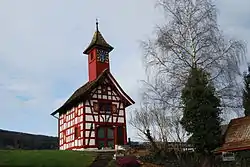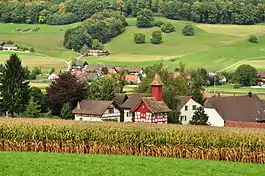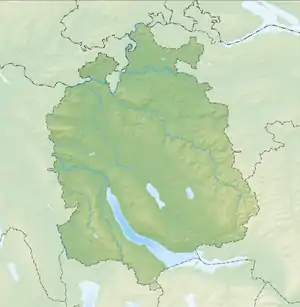Schleinikon
Schleinikon is a municipality in the district of Dielsdorf in the canton of Zürich in Switzerland.

Schleinikon | |
|---|---|
 | |
 Coat of arms | |
Location of Schleinikon | |
 Schleinikon  Schleinikon | |
| Coordinates: 47°30′N 8°24′E | |
| Country | Switzerland |
| Canton | Zurich |
| District | Dielsdorf |
| Area | |
| • Total | 5.65 km2 (2.18 sq mi) |
| Elevation | 472 m (1,549 ft) |
| Population (31 December 2018)[2] | |
| • Total | 728 |
| • Density | 130/km2 (330/sq mi) |
| Time zone | UTC+01:00 (Central European Time) |
| • Summer (DST) | UTC+02:00 (Central European Summer Time) |
| Postal code(s) | 8165 |
| SFOS number | 0098 |
| Surrounded by | Boppelsen, Niederweningen, Oberweningen, Otelfingen, Regensberg, Siglistorf (AG) |
| Website | http://www.schleinikon.ch SFSO statistics |
Geography

Situated in the Wehntal, Schleinikon has an area of 5.7 km2 (2.2 sq mi). Of this area, 49.9% is used for agricultural purposes, while 43.2% is forested. Of the rest of the land, 6.7% is settled (buildings or roads) and the remainder (0.2%) is non-productive (rivers, glaciers or mountains).[3]
Demographics
Schleinikon has a population (as of 31 December 2020) of 858.[4] As of 2007, 5.7% of the population was made up of foreign nationals. Over the last 10 years the population has grown at a rate of 9.4%. Most of the population (as of 2000) speaks German (95.8%), with English being second most common ( 0.6%) and Serbo-Croatian being third ( 0.6%).
In the 2007 election the most popular party was the SVP which received 39.8% of the vote. The next three most popular parties were the SPS (18.3%), the CSP (12.9%) and the Green Party (11.4%).
The age distribution of the population (as of 2000) is children and teenagers (0–19 years old) make up 27% of the population, while adults (20–64 years old) make up 63% and seniors (over 64 years old) make up 10%. In Schleinikon about 84% of the population (between age 25-64) have completed either non-mandatory upper secondary education or additional higher education (either university or a Fachhochschule).
Schleinikon has an unemployment rate of 0.92%. As of 2005, there were 45 people employed in the primary economic sector and about 18 businesses involved in this sector. 24 people are employed in the secondary sector and there are 6 businesses in this sector. 34 people are employed in the tertiary sector, with 13 businesses in this sector.[3]
References
- "Arealstatistik Standard - Gemeinden nach 4 Hauptbereichen". Federal Statistical Office. Retrieved 13 January 2019.
- "Ständige Wohnbevölkerung nach Staatsangehörigkeitskategorie Geschlecht und Gemeinde; Provisorische Jahresergebnisse; 2018". Federal Statistical Office. 9 April 2019. Retrieved 11 April 2019.
- Swiss Federal Statistical Office accessed 04-Aug-2009
- "Ständige und nichtständige Wohnbevölkerung nach institutionellen Gliederungen, Geburtsort und Staatsangehörigkeit". bfs.admin.ch (in German). Swiss Federal Statistical Office - STAT-TAB. 31 December 2020. Retrieved 21 September 2021.